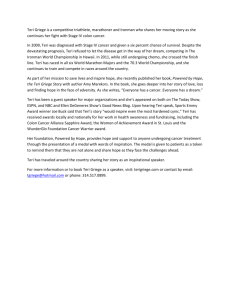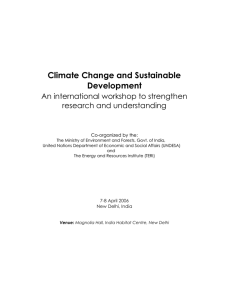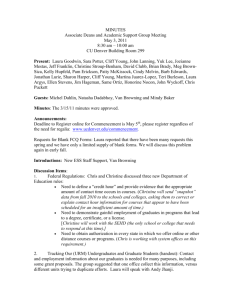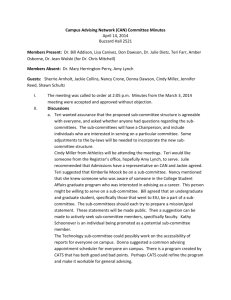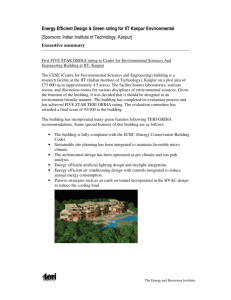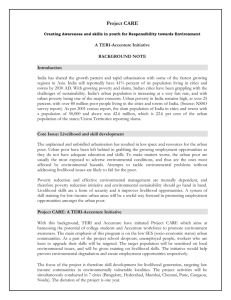Annual review - Department for International Development
advertisement
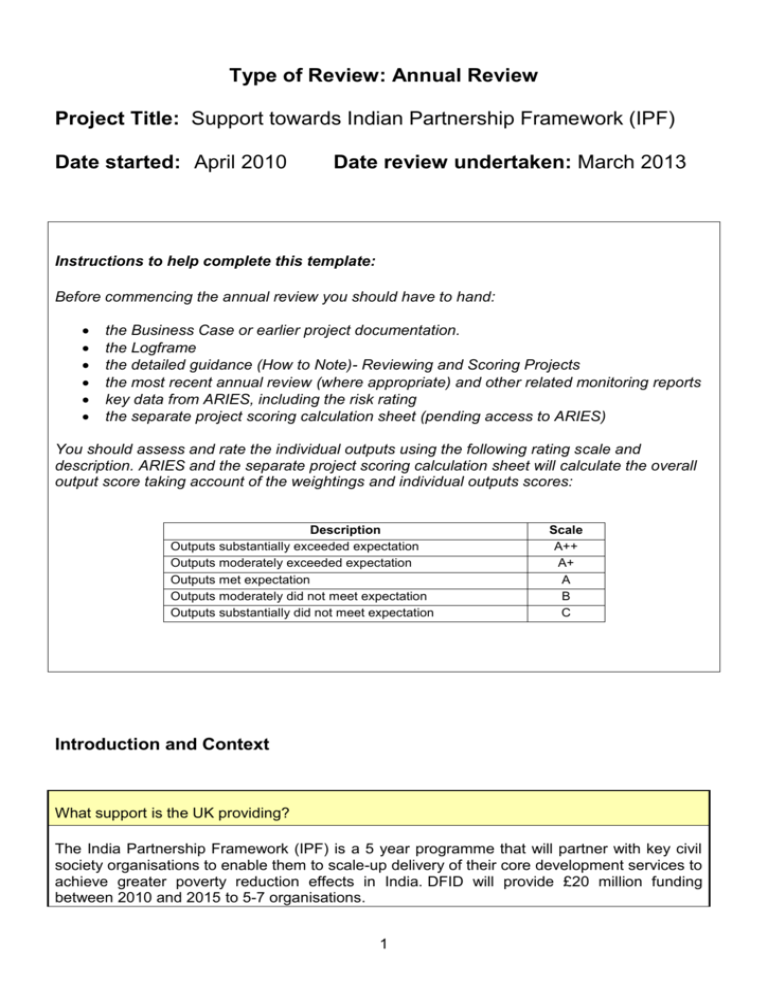
Type of Review: Annual Review Project Title: Support towards Indian Partnership Framework (IPF) Date started: April 2010 Date review undertaken: March 2013 Instructions to help complete this template: Before commencing the annual review you should have to hand: the Business Case or earlier project documentation. the Logframe the detailed guidance (How to Note)- Reviewing and Scoring Projects the most recent annual review (where appropriate) and other related monitoring reports key data from ARIES, including the risk rating the separate project scoring calculation sheet (pending access to ARIES) You should assess and rate the individual outputs using the following rating scale and description. ARIES and the separate project scoring calculation sheet will calculate the overall output score taking account of the weightings and individual outputs scores: Description Outputs substantially exceeded expectation Outputs moderately exceeded expectation Outputs met expectation Outputs moderately did not meet expectation Outputs substantially did not meet expectation Scale A++ A+ A B C Introduction and Context What support is the UK providing? The India Partnership Framework (IPF) is a 5 year programme that will partner with key civil society organisations to enable them to scale-up delivery of their core development services to achieve greater poverty reduction effects in India. DFID will provide £20 million funding between 2010 and 2015 to 5-7 organisations. 1 What are the expected results? The following high-level objectives will provide an aggregate measure of poverty impact and effectiveness of selected organisations. Each partnership will deliver results in: - development objectives (anticipated results, scale and coverage of a partner’s activities); organisational effectiveness objectives (improvements in organisational business planning and efficiency); and partnership objectives (strengthened collaboration and dialogue with DFID for a combined impact on poverty in India). To maximise the impact on the development, organisational and partnership objectives, the last Annual Review (2012) recommended that IPF further focus on three pillars through which CSOs can deliver change and impact: (1) Information to the currently excluded and the poorest; (2) Empowerment through their greater participation and action for change; and (3) Innovative approaches, potentially using technology applications, that enable better information and empowerment. The global debate on poverty and post MDG framework is increasingly led by emerging powers and low income countries (LICs) where India’s global position is one of increasing influence and assertiveness. Its impact on poverty in low income countries, particularly in Africa is growing and there is strong interest from developing countries to share experiences and lessons with India. IPF invests in building such global partnerships between India and LICs to promote adapt/adopt/test technology and proven approaches for poverty reduction. The partnerships with TERI and Digital Green reflect this focus and aims to reach poor communities using cost effective technology platforms. Partnerships with SEWA Bharat and Population Foundation India (PFI) and others currently under discussion, also have these areas built into their proposals. What is the context in which UK support is provided? DFID India recognises the need to engage with a diverse set of non-state partners to deliver greater scale and coverage, and build effective and lasting institutions that can make significant contributions to poverty reduction efforts in India. The India Partnerships Framework (IPF) aims to work with Civil Society Organisations (CSOs) to improve their effectiveness to consolidate delivery of development results at scale; Financial instability and poor mid-management leadership often creates disincentives for organisations to plan for the long-term and therefore comprise their potential to poverty reduction policies and outcomes. The IPF addresses these constraints by providing resources that: catalyse each organisation’s ability to deliver high-quality results at scale, consistent with their core comparative advantage; and, facilitate strategic investment in business planning and institutional capability to achieve greater impact from available resources. Government and business in India recognise the role of non-state actors in leveraging solutions that can have transformative effects on the lives of India’s poorest. IPF specifically 2 responds to the need to directly partner with key CSOs in supporting and scaling their existing work as recommended by UK Parliament’s International Development Committee (IDC) report. The report recommended greater work with civil society in India which was endorsed by the UK Government. The IDC report was based on a cross-party visit of UK parliamentarians to India in 2011. In November 2012, the Secretary of State announced that post 2015, UK aid to India will focus on three strands: Technical Cooperation; private sector development; and global partnerships. Civil society partners currently play a role in each of these three evolving strands. IPF gives DFID-India the opportunity to leverage multiple and varied platforms to sharpen its approach in all the three strands. Section A: Detailed Output Scoring Output 1: TERI scales up research and programme interventions to address environmental sustainability and access to energy in India’s poorest states. Output score: A Output met expectation Progress against expected results: The partnership with The Energy Research Institute (TERI) is in its second Year (started August 2011), and focuses on scale up use of clean energy technologies in India and Africa through: a) creation of sustainable business models for improved cooking technologies and solar micro-grids and solar charging stations for lighting; b) strengthen its policy outreach; and c) build internal capacity. (TERI logframe EDRM No. 3033217). TERI has made good overall progress on developing sustainable models for cook stoves and lighting, and is on track to meet its overall targets. In response to the feedback from the field and in discussion with DFID, TERI modified its implementation approach and moved to an integrated approach of energy enterprises for lighting and cook stoves. TERI now promotes: a) robust market mechanisms by building capacity of existing technology manufacturers, and b) encourage entry of more commercial players in the sector to foster technology innovation and competition. It has done this through networking with stakeholders namely manufacturers and civil society partners, and in-house research and development. TERI is also building value chains that offer quality products and after-sales service. DFID and TERI have agreed a policy matrix which looks at both external push factors (e.g. external demand, global significance, etc.) and TERI’s internal pull factors (e.g. TERI’s vision and mission) to prioritise the list of activities to be undertaken. After initial delays, ten subprojects to inform policy formulation and program implementation have been developed. These include green growth and energy security. DFID and TERI have put in place robust management and governance mechanisms to make strategic decisions, review progress and agree work plans. Two Steering Committee meetings (strategic decision making body), and five Management Committee meetings were held in the year to review progress. Indicator-1: Additional number of poor Indian households adopting improved cooking energy products 3 Baseline-0, Milestone for 2013 - 500; Achieved (by March 2013) – 409; Target (2015): 100,000. By March 31, 2013, Phoenix Udyog Pvt. Ltd. Himachal Pradesh (commercial manufacturer of TERI design stove) has already supplied 870 cook stoves to entrepreneurs out of which 409 stoves have been adopted by end users. Per unit cost of the cook stove is around INR 4000 and the end user pays INR 2700. The remaining cost is subsidised by TERI to cover manufacturer and distributor’s margin, taxes and transportation cost. The subsidy is provided for initial market seeding and technology penetration. DFID team is in discussion with TERI to take steps to graduate it in to a market based model in an agreed time frame. Through its communication and outreach activities, TERI has generated demand of more than 1000 “forced draft” cook stoves across four states1 in India. However, supply chain constraints have slowed down the distribution process. A detailed assessment by TERI of Phoenix Udyog Pvt, and its stove production facility identified specific measures to increase production efficiency through better human resource planning, improved assembly line and stringent quality control protocols. With these changes, the production is expected to significantly increase in the year ahead. Dhara Energy in Karnataka developed a prototype of TERI SPT_0610 stove model. The prototype successfully met all performance benchmarks prescribed by Ministry of New and Renewable Energy (MNRE). Dhara is in process of setting up a production facility with a capacity of 1,000 stoves per month. Three new business dissemination models/partnerships were developed and operationalized by TERI to scale up adoption of cooking related products and service. It entered into partnerships with: 1. NGOs for promotion of clean energy (both cooking and lighting) technologies and financial institutions2 for provision of affordable consumer finance. 2. Producer Companies promoted by farmers under District Poverty Initiative Program (DPIP) in Madhya Pradesh. DPIP supports the value chain through: a) capital support for infrastructure; b) human resource to Producer Companies; c) IEC for cook stoves; and d) loan to Village Development Committees (Farmer SHG Federations) for further micro-lending. VDCs provide financing to the end-users (farmer shareholders), who register orders with the Producer Company. 3. Nav Durga Metal Industries (NDMI), Uttar Pradesh to promote MNRE approved forced-draft stove “Agni Star” in other states. Indicator- 2 and 3 (additional number of poor African households adopting improved cooking energy products and clean lighting products, respectively) relate to activities funded through Global Development Partnership Programme and are reported there. The annual review of TERI monitors progress on these indicators as well and also explores opportunities to promote the models developed under IPF, within Africa. Indicator-4: Additional number of Indian households with solar lighting having access to or using functional Technology Resource Centres: Basline-0, Milestone - 135,000; Achievement – 45,000 but on track to meet the end line. 1 Himachal Pradesh, Madhya Pradesh, Odisha, and Uttar Pradesh a regional rural bank (Aryavart Grameen Bank in Uttar Pradesh; Utkal Grameen Bank in Odisha and Maha Shakti Foundation in Odisha] 2 4 Target (2015) – 405,000 The target could not be met as the implementation approach was significantly revised. However, TERI is committed to reach the overall target of 405,000 additional households by the end of project. In the initial model of Technology Resource Centres (TRC), a single agent was responsible for maintenance of a cluster of 20 Solar Charging Stations (SCS). However, TRC faced major constraints of after sales service, commercial sustainability, and capacity. TERI then shifted to an Energy Enterprise (EE) model that provides last mile delivery for both cook stoves and home based lighting in rural areas. EEs focus on strong after sales support for renewable energy based products, service the demand of quality solar lighting products and maintain Solar Charging Stations and Solar Micro-grids (SMGs). TERI saw this as an imperative step towards sustainability of solar lighting initiatives across India since the EE represents an institution with several individuals working together as against a single person in the TRC. As of now, 950 SCS have been linked to the energy enterprises which translate into around 45,000 households that are being served with quality and affordable lighting solutions. In addition to this, EEs have also started selling quality and affordable solar lighting products in their command areas thereby diversifying the technology options for rural consumers. TERI has facilitated the establishment of 55 energy enterprises which are now operational in 11 states3 across India. Most of these enterprises are fresh start-ups while some of them are already established and extend assistance to their nearest EEs. The energy entrepreneurs, the “last mile agents”, will facilitate sales and service of clean energy technologies for improved cook stoves and quality solar lighting products. Innovative incentive mechanisms have been put in place to support the EEs in the initial phase. A series of orientation workshops and comprehensive training workshops were conducted across five states4. Concerted efforts have been put by the state level Project Management Units (PMUs,) created under the project to connect these EEs to the existing solar charging station/ micro-grids in their identified territory while providing necessary support to establish new SCS/ SMGs. Indicator-5: No. of citations of TERI research in national and international journals Basline- 400, Milestone - 450; achieved -700; Target (2015) - 550 In 2012, 700 citations of TERI’s research was made in national and international newspapers. The “policy matrix” developed last year will help to prioritise the most relevant interventions and strengthen TERI’s capability to promote knowledge sharing and policy outreach. Indicator-6: Number of patents filed as a result of TERI research Basline-20, Milestone -24; Achieved: 23; Target (2015) - 30 TERI has filed three patent applications which relate to extending clean energy access to rural areas through clean cooking and solar lighting. This is lower than the target mainly as TERI’s focus during the year was on establishing systems, procedures and tools for effective roll out of the revised implementation approach. The three patents filed are: i) the improved cook stove design TERI (SPT _0610); ii) a Solar 3 Andhra Pradesh, Assam, Bihar, Himachal Pradesh, Jharkhand, Karnataka, Madhya Pradesh, Maharashtra, Meghalaya, Odisha and Uttar Pradesh 4 Madhya Pradesh, Uttar Pradesh, Bihar, Odisha and Assam 5 Home Lighting System with dual charging system with a special low capacity (10 Ah) tubular battery and; iii) the Solar DC Micro Grid (SMG). The Solar powered micro-grids (SMG) are modular in nature and the generation capacity can be tailored to suit local demand. It involves a centralized power generation (solar panels) and storage (battery) system that can service a cluster of 10-100 households/shops. Power generated during the day charges battery banks and is distributed for 4-5 hours during the night to households/ commercial entities (small shops) that have LED (light-emitting diode) lights that consume less power, installed. Recommendations: Policy advocacy remain a priority for the partnership and an area where TERI needs to have a clear approach and demonstrate results. TERI should focus on implementation of the policy matrix and optimise transformative potential of each policy intervention. Specifically it must upscale the cook stoves models and share the field-based knowledge and lessons with policy makers. The Joint TERI-DFID management committee is responsible for following up on the recommendations around policy advocacy. Impact Weighting (%): 40% Revised since last Annual Review? Y/N N Risk: Low/Medium/High: Low Revised since last Annual Review? Y/N N Output 2: National membership of SEWA expanded to strengthen the national movement for women working in informal economy. Output score: C Outputs substantially did not meet expectation Progress against expected results: The Task Team is in the final stages of negotiations for partnership with SEWA Bharat that will focus on economic and social empowerment of women workers in the informal sector. The proposed partnership will be for £1.3 million and will reach over 100,000 women. The proposal with SEWA / Sewa Bharat5 went through several rounds of iterations from its original intent. It is now more responsive to the development priorities of the poor states, better aligned with IPF and DFID-India’s transition plan and within the management capacity of SEWA Bharat. The proposal is now close to final and the partnership is likely to start by mid2013. The project will enhance the financial inclusion of poor women and girls in two poor states – Bihar and Rajasthan – through a credit cooperative and financial literacy; build their ability to tap market opportunities and leverage SEWA Bharat’s partnerships with domestic and SEWA – Self-employed Women’s’ Association, Ahmedabad was set up as a union in 1972 and converted into a Society in 1984; Sewa Bharat: a federation of the independent SEWA in different states. 5 6 international networks such as HomeNet and Fair Trade for consistent advocacy for improved domestic and global policies for women in the informal sector and to mentor organisations in at least two LICs. It will complement DFID-India’s other programs, in particular, PSIG and PACS. Due diligence assessment conducted by DFID-India for SEWA/Bharat reported no critical or high priority financial or operating weaknesses. Recommendations to mitigate medium and low priority financial and/or operating weaknesses include a strong program monitoring system, revisions in the procurement policy and anti-corruption and fraud strategy measures in place. Impact Weighting (%): 30% Revised since last Annual Review? Y/N N Risk: Low/Medium/High: Low Revised since last Annual Review? Y/N N Output 3: To demonstrate a replicable model for improving food security and health outcomes of 36,000 rural poor households (187,200 individuals) through ICT in India and LICs (DG) Output score: A Output met expectation Progress against expected results: DFID signed the Accountable Grant Agreement with Digital Green (DG) on 1st September 2012 for £2.6 million under IPF. The project will improve the food security and health outcomes for rural communities in India’s poorest states and two other low-income countries (LICs). Digital Green aims to train 60,000 households with improved agriculture or health practice and ensure its adoption by 36,000 households. One third of these results will come from LICs. Digital Green Foundation has successfully used technology to promote agricultural practices in rural India. Community members are trained to use video cameras and produce educational videos to address the needs and interests of the community. Field workers use low-cost battery-operated “pico projectors” to screen the videos for an interactive discussion with the communities. With IPF support, DG will adapt its approach to focus on food security and nutrition and replicate it in Ghana and Ethiopia. It will also build a virtual training platform specially targeted at the communities and partners in Africa and South Asia. The core objectives of the partnership are: (i) (ii) (iii) Extend and expand the DG approach in India and at least two LICs in areas of agriculture and health to demonstrate wider innovation and accountability. Strengthen training and quality assurance support to replicate Digital Green approach with public sector and civil society partners in India and LICs Innovate the Digital Green approach through research and evidence for further replication in India and LICs and share lessons globally. 7 In last six months DG has established partnerships with six key organisations in India (Madhya Pradesh, Odiasha, Uttar Prdesh) and Africa (Ghana, Ethiopia)6 and is in discussion with several others including Cereal Systems Initiative in South Asia (CSISA) and ENGINE (a USAID-funded nutrition integration project). Digital Green has begun work on two important activities – a) a virtual training platform, built around its library of videos that will integrate community feedback and usage data (both online and offline); and b) a unified monitoring and evaluation strategy for its work across geographies and sectors. A variety of formative research is planned to assess the qualitative aspects of institutionalizing its approach. International Food Policy Research Institute (IFPRI), for instance, will study the pilots in India to understand their feasibility and to compare the uniqueness of each context. Collaborations with London Business School, London School of Economics, and Cambridge University, all under discussion, will leverage DG’s farmer-level database for a variety of market and social network theory-based research, DG presented its approach to the health Technical Assistance teams to explore opportunities for collaboration especially for community outreach and capacity building support for frontline workers in DFID’s focus States. Indicator 1: Cost per adoption of new practices delivered by agriculture and health extension agencies. Baseline: £6-24 per adoption of new agriculture practices by farmers working with NGOs in India and Ghana (8); No Milestone for year one The partnerships are at different stages of evolution. For some such as the one in Uttar Pradesh, and Ghana, videos have been produced and disseminated by local intermediaries. For other partnerships, such as those in Odisha, Madhya Pradesh, and Ethiopia, video production and dissemination have just begun. Cost per adoption data will be captured only after these initial pilot projects have reached a more completed stage, as video production and dissemination data becomes available. Indicator 2: Number of rural households (individuals) trained on improved agriculture practices and health behaviours in India and LICs Baseline: 88,000 rural households (422,000 individuals) involved with agriculture NGOs in India (9); Milestone (by Sep 2013): 4,000 rural households trained in health in India; 6,000 households trained with public non-NRLM agriculture partners in Orissa and Bihar; 3,000 households trained in agriculture in LICs; 2,000 households trained in health in LICs It is too early to get the number of rural households (individuals) trained on improved agriculture practices and health behaviours in India and LICs under this project. The progress made so far in setting up partnerships and training on video production, suggests that the target for the year will be met. Recommendations: 6 Agriculture: 1. District Poverty Initiatives Project (DPIP), Madhya Pradesh, India; 2. World Cocoa Foundation (WCF), Ghana; 3. International Development Enterprises (IDE), Ethiopia; 4. Oxfam America (OA) / Sasakawa Africa Association (SAA) / Ministry of Agriculture (MoA), Ethiopia; Health:1. SPRING/VARRAT, Odisha, India; 2. PATH, Uttar Pradesh, India 8 Digital Green has a strong background on agriculture but needs to build its institutional capacity on health and nutrition. As it develops this stream it must : prioritise key behaviours and practices; review on-going successful initiatives and institutional platforms (NRHM, ICDS,) that can be leveraged; align its work more closely with DFID’s health and nutrition programs in India and in other LICs; and based on the above agree an updated work plan with the DFID Task team by June 2013. Impact Weighting (%): 30% Revised since last Annual Review? Y/N Y Risk: Low/Medium/High: Low Revised since last Annual Review? Y/N Yes Section B: Results and Value for Money. 1. Progress and results 1.1 Has the logframe been updated since last review? Yes Following changes have been made: TERI sub-log frame was revised following the change in approach. Output on partnership with Digital Green added. 1.2 Overall Output Score and Description: B Outputs moderately did not meet expectation IPF has made satisfactory progress. TERI has progressed well, DG Accountable Grant signed, partnerships with Sewa Bharat and Population Foundation India (PFI) and dialogue initiated with Federation of Indian Chambers of Commerce India (FICCI) and Fairtrade India. However, IPF can report only in the live partnerships out of the 5-7 envisaged in the Programme Memorandum. TERI has made good progress especially in promotion of cook stoves where targets have been exceeded and once the network of Energy Enterprises is active, solar lighting will also pick up. Once the initial incubation period is over and the nuts and bolts of the model worked out, the Energy Enterprises can emerge as viable business units. Progress against the policy outreach work was slow but with the Policy Matrix in place will now be more strategic and transformative. DFID signed an Accountable Grant with Digital Green on 1st September 2012; the substantive results will be available at the end of one year. The project has made good progress by establishing partnerships in India and low-income countries in Africa. It has trained 180 participants on video production, dissemination and data management. The proposal from both Sewa Bharat and PFI are close to final, due diligence completed and 9 the Accountable Grant is likely to be signed by end of May 2013. Partnership with PFI: DFID is considering a proposal for £2.6m from the Population Foundation of India (PFI) to improve demand, access and quality of family planning services in India with particular attention to Bihar, Madhya Pradesh and Odisha. Investment will be targeted towards: a) building women’s decision making; b) influencing young people to adopt correct family planning methods; and c) advocacy for family planning, as a tool to improve maternal and child health, amongst the politicians and bureaucracy. The initiative will complement on-going financial and technical assistance in the three states to improve access and quality of maternal and child health and nutrition services. 1.3 Direct feedback from beneficiaries: Field visits included discussions with project beneficiaries. Women SHG members reported that their quality of life had changed. Children could study longer, shops could remain open for longer time and they could finish some of their pending domestic works such as embroidery in the night. Community member also reported some problem with the switch of the lanterns but appreciated that it was rectified quickly. TERI has also undertaken some feedback from users, manufacturers and suppliers of the cook stoves during their field testing and pilot testing phase in 2012. Furthermore, the evaluation will involve detailed stakeholder consultation, including with direct beneficiaries of cooking and lighting, to assess impact. 1.4 Summary of overall progress Overall progress has been satisfactory. Progress against last year’s recommendations: Recommendations Progress TERI to develop a comprehensive strategy A one year strategy and costed work plan for translating research and outreach into (upto June 2013) was developed by TERI, policy formulation and implementation. This and approved by the Steering and will identify prioritised areas of where we Management Committees. Discussions for want to achieve policy change, define what the project period June 2013 – 2015 are success would look like, and how this might currently underway. be integrated into policy plans. This will be discussed at the next Management DFID-TERI developed a policy matrix that Committee meeting (June 2012) prioritises all activities to be funded under the project. TERI to develop a comprehensive approach Some of this has been incorporated in the for improving its own institutional capacity to Matrix for Output 3, to help TERI prioritise its plan and deliver its strategic objectives, and policy outreach activities. define how this adds value to the organisations objectives and strategies. First full review to be undertaken in July Full review was conducted in July 2012 and 2012; preceded by Management and 7 Management and Steering Committee Steering Committee meetings to endorse the meetings were held. Key issues discussed overall approach, assess progress against included: progress against annual targets, annual targets, identify key challenges and revision in the model based on emerging opportunities. lessons, framework for policy formulation. Activities to strengthen TERI’s networking TERI has begun procurement of its IT systems, data storage and connectivity have systems. It is yet to develop a begun. The Steering Committee has asked comprehensive approach paper on 10 TERI to produce a more ambitious approach paper that goes beyond IT based activities, and add strategic value to strengthening organisation capacity (including human resource and financial capability). DFID internal team meet to consider the potential of the present proposal, including the potential for SEWA to deliver results in: Community accountability Initiative (especially Health) Women and work (jobs and skills) strengthening organisational capacity. DFID conducted a financial check of TERI’s systems (March 2013) and recommended quarterly review of expenditure against planned allocations; and maintaining an inventory list. The proposal is in the final stages of approval. A due diligence assessment of SEWA’s capacity to implement the project was conducted by DFID India internally. The Task Team hopes to have the partnership in place by June. Self-help groups (strengthen, define, analytical work). The outcome of the internal discussions should be followed up with SEWA. To maximise the impact on the development, organisational and partnership objectives this review suggests IPF be used as a platform to further focus on three pillars through which CSOs can deliver change and impact: (1) Information to the currently excluded and the poorest; (2) Empowerment through their greater participation and action for change; and (3) Innovative approaches, potentially using technology applications, that enable better information and empowerment. The DG proposal reflects a sharper focus on the three pillars. New partnerships will also include emphases on these areas. 1.5 Key challenges The internal task team challenge of time management and competing priorities, identified in the last annual review continues. The process of these potential partnerships, involving detailed appraisal work, finalising key results and ensuring their fit with new forward priorities has been time intensive, especially at a time of numerous competing demands. Each partnership has its own log frame and a review cycle. The present Annual Review format with one output for each partnership does not sufficiently capture the full depth of progress under IPF. This includes the evolution since IPF was originally designed with the additional focus on the poor and their participation, technology and global partnerships. Challenges for TERI include – a) ensure operational support and oversight to fully ground and embed the new approach; b) implement the policy matrix; and c) monitoring financial forecast and spends – the spend was low this year mainly because of the time taken to roll out eh revised approach and is expected to pick up. For DG the main challenge will be to build its capacity on health and nutrition and have a responsive approach in place. 11 1.6 Annual Outcome Assessment = B moderately did not meet expectation IPF has made satisfactory progress and is on track to have all the partnerships in place by March 2014. However for the annual review two partnerships are live. The partnership with TERI is progressing well and TERI has made good overall progress on developing sustainable models for cook stoves and lighting, and is on track to meeting its overall targets. TERI project has made steady progress against outputs and is expected to improve the lives of about 400,000 women. The partnership with Digital Green started 6 months ago and has made some progress by establishing partnerships with key organisations in low-income states in India and low-income countries in Africa. Major progress has been made in developing partnerships with PFI and SEWA. The proposals are almost finalised and team is preparing submissions for approval. 2. Costs and timescale 2.1 Is the project on-track against financial forecasts: Y/N The overall spending under IPF is low as compared to forecast due to the delay in start of partnerships. However with both TERI and DG in implementation mode and three more partnerships potentially in place, the spend is expected to be higher next year. Under TERI project we spent £1.29m during last year against the forecast of £2m. Digital Green has spent £456,207 in last 6 months. 2.2 Key cost drivers DFID plans to have at least 5 partnerships and provide funding up to £20m till March 2015. We have allocated around £17m out of £20m under IPF with 5 partners (2 partnerships signed and 3 are in progress). Funds under the TERI grant are allocated for, capacity building and networking, hardware (cook stoves and Technology Resource Centre), equipment, communication and professional costs. For Digital Green funds are earmarked for equipment, trainings, sub-grants to partners, research, evidence and dissemination, professional fee and travel. 2.3 Is the project on-track against original timescale: IPF has faced significant delays in signing partnerships with organisations. TERI partnership was delayed by almost one year and started in August 2011. Digital Green project started in September 2012 and the partnerships with PFI and SEWA, are likely to start mid-2013. The task team is in the process of seeking a one year extension for the project to March 2016. The objectives of the IPF align well with SoS’s announcement for India and the post 2015 priorities. The Task Team recommends March 2014 as the cut-off date for finalising all the partnerships, with a minimum period of 24 months for implementation. The Task Team anticipates that a number of the new partnerships (SEWA, PFI and FICCI for example) will be 12 operational well before March 2014. 3. Evidence and Evaluation 3.1 Assess any changes in evidence and implications for the project Too early to assess the changes. 3.2 Where an evaluation is planned what progress has been made? DFID has agreed a comprehensive program evaluation plan with TERI. Under this two evaluations will be conducted - first will begin by July 2013 and the second will be at the end of the project. 4. Risk 4.1 Output Risk Rating: Low/Medium/High: The programme is considered to be of Low risk. 4.2 Assessment of the risk level TERI - The risk level remains Medium. The Steering and Management Committee meetings, with senior representation from DFID and TERI, provide strategic oversight and closely monitor progress. This ensures that emerging risks are flagged up at an early stage and mitigation measures are put in place. The main risks are around the potential for TERI’s work to influence policy makers and practitioners. The policy matrix and outreach plans will help to mitigate this risk. Another remaining risk is around TERI’s capacity to effectively utilise resources. DFID and TERI will undertake detailed discussions on budget requirements for the remainder of the programme whilst agreeing work plans for Year 3 in August 2013. Digital Green - The capacity of Digital Green and financial due diligence checks were conducted by Dalberg Global Development Advisers on behalf of the Bill and Melinda Gates Foundation (BMGF). The key risks to achievement of development outcomes through this DFID support will be staff expansion and the need for additional skilled capacities in public health. DFIDI will monitor and manage risks through a combination of six-monthly in-depth review meetings, field visits and independent assessments. DFID Ethiopia staff may also be involved in monitoring activities in Africa. A due diligence assessment of SEWA and PFI’s capacity to implement the project was conducted by DFID India internally. No Critical or High Priority financial or operating weaknesses were observed during the Assessment. However, Medium or Low priority financial and/or operating weaknesses were observed and appropriate mitigation measures will be included in the partnership agreement. 4.3 Risk of funds not being used as intended Risk of funds not being used as intended is Low. An initial “Due Diligence” assesses the partner’s capacity to use funds. Resources are earmarked for further capacity building. 13 Rigorous financial management assessments, including payment in arrears, continue through the life of funding. TERI - As part of this review process, DFID conducted a check of TERI’s financial systems (March 2013), and found risk of funds not being used as intended is low. TERI has a structured financial management team, with clear roles and responsibilities assigned. It has robust financial mechanisms and record keeping system; Enterprise Resource Planning (ERP) is used as a financial management tool. Their books of accounts are largely in line with the audit requirements and the TERI Director is the approving authority for all programme spend. We have recommended to TERI that they maintain and share with DFID a quarterly Expenditure v/s Targets achieved Matrix which will help us monitor project progress in terms of the outputs achieved against spend for each quarter. They also need to work closely on maintaining the inventory list for this project. DFID recommends continuing the practice of an annual financial assessment as part of the review process. 4.4 Climate and Environment Risk TERI: The programme is expected to deliver substantial benefits in terms of reduced greenhouse gas (GHG) emissions and provide major benefits in the areas of health (reduced indoor air pollution), education (lighting), quality of life (drudgery reduction) and reduced deforestation. Negative environmental impacts can however result from improper disposal of lead-acid batteries used in solar lighting systems that can cause soil and water contamination. Ensuring better battery life and recycling can minimise this impact. TERI needs to monitor environmental performance (including GHG accounting) of project activities and undertake risk assessment/ mitigation of any negative environmental impacts. Digital Green: Digital Green’s agricultural interventions will focus on rural geographies in which partners focus on small-scale (i.e., less than 2 hectares) very poor farmers, dependant on rain-fed agriculture. DG’s videos on relevant agricultural practices like natural resource management or improved crop production will increase yields, decrease costs, and enhance resilience to climate change. 5. Value for Money 5.1 Performance on VfM measures Initial assessments by DFID suggest that TERI is applying value for money principles. The concurrent program evaluation planned from June 2013 will look more closely at the economic rates of return. For cook stoves, TERI has underspent on its budget but over-exceeded its targets suggesting savings for DFID. The Energy Enterprise model also suggests a value for money approach, as the investment costs are borne by the entrepreneur and TERI invests in capacity, outreach, quality of services, and networking. Too early to assess for Digital Green partnership as the project started in September 2012. 5.2 Commercial Improvement and Value for Money TERI has standard procurement processes that have been agreed with DFID at the start of the grant. TERI is also maintaining an inventory of all items of equipment purchased, and supplies this to DFID annually. 14 Digital Green proposal was reviewed by the DFID team and Due Diligence was done. The budget was thoroughly checked, negotiated and reduced to £2,684,766 from £3,538,618. 5.3 Role of project partners The project is about strengthening the strategic capacity of partners in implementing poverty reduction initiatives. All the projects under this framework will be implemented by civil society partners. 5.4 Does the project still represent Value for Money : Y Yes. 5.5 If not, what action will you take? NA 6. Conditionality 6.1 Update on specific conditions: None 7. Conclusions and actions IPF has done better this year. Partnership with TERI is beginning to show results, DG has begun roll out of its activities and partnerships with SEWA and PFI are close to final. The DG initiative along with the SEWA and PFI projects under design, include a sharper focus on information, empowerment and innovative use of technology, as recommended in the last annual review. Priority for IPF next year will be: a) Seek an extension of the project to March 2016 and finalise all projects by March 2014; b) Monitor work plans and progress to ensure that the respective partnerships: i) reach the poorest; ii) promote innovation/technology and iii) build complementarity with DFIDIndia/LICs programs; c) Review the log frame and reporting structures to ensure that the progress of IPF overall and individual partnerships is rigorously assessed and reported. 8. Review Process The review was based on quarterly Progress Reports, field visits by DFID staff, monthly Management Committee meetings, quarterly Steering Committee Meetings and review of annual work plans. 15
